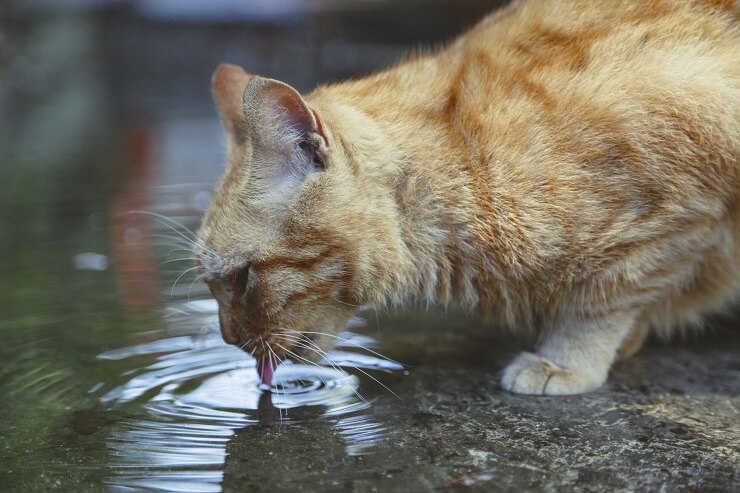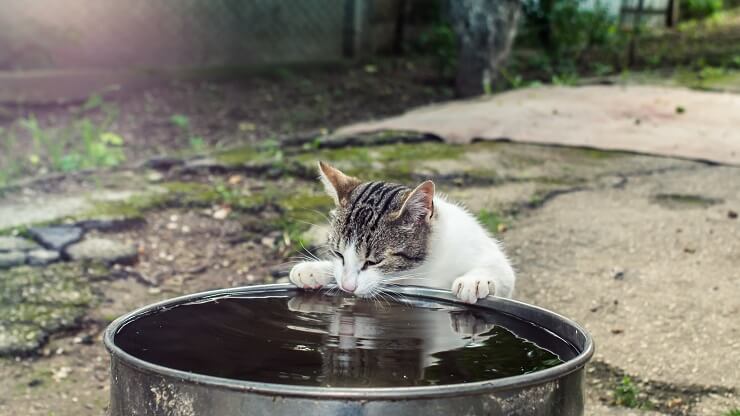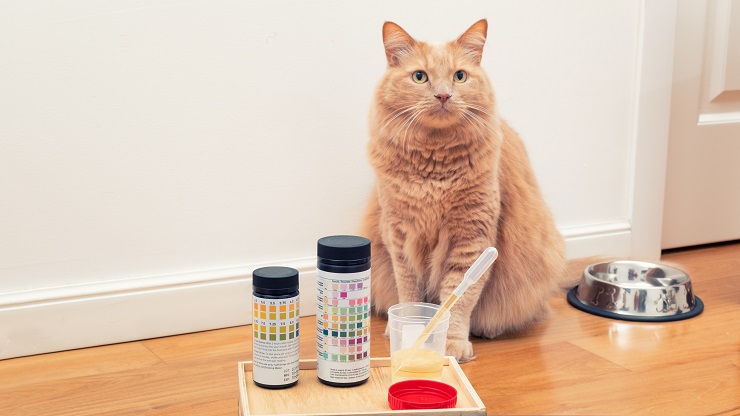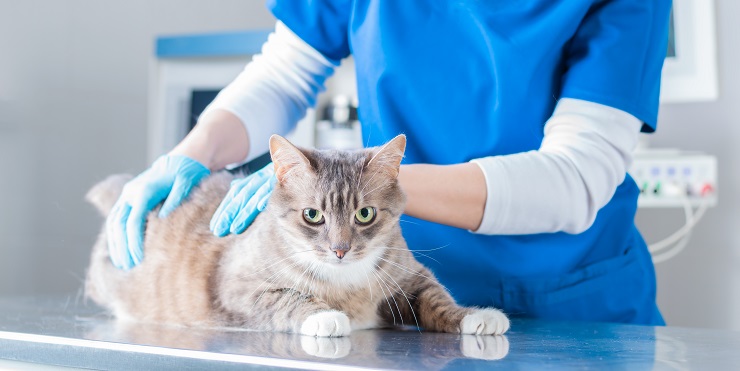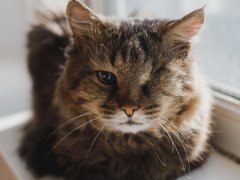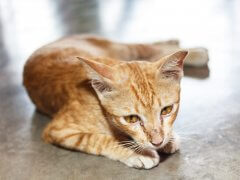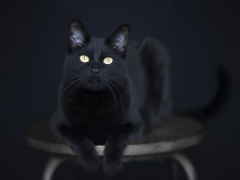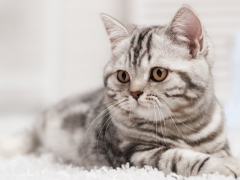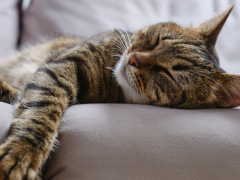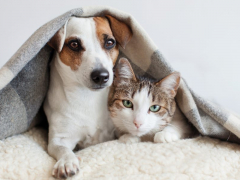The term “polydipsia” simply means “excessive thirst” or “drinking too much water”. The aim of this article is to summarise the important information about cats with increased drinking: how do owners know that this is a problem, what can cause it, and what owners need to do when this is noticed?
Quick Overview: Polydipsia In Cats
What Does It Mean When a Cat Suffers From Polydipsia?
The term “polydipsia” is derived from two Greek words: “poly” meaning “much or many” and “dipsos” meaning “thirst”. So a cat with polydipsia means a cat whose water intake is more than normal.
Polydipsia is usually linked to another problem: polyuria. This means “producing too much urine”: the basic connection is that if a cat is drinking too much water, it’s very likely that the fluid will emerge at the other end, as urine.
So veterinarians often talk about the combination of signs: polyuria-polydipsia, abbreviated to PUPD.
- Sometimes, a case may be described as “primary polydipsia”, meaning that the excessive drinking was the original problem, and the increased urination was the consequence. Psychogenic polydipsia is an example.
- In contrast, “primary polyuria” means that the increased urine production was the original problem, with this in turn leading to increased thirst. Diabetes mellitus is an example, with the extra glucose in the urine drawing out fluid from the kidneys, leading to excess thirst.
How Common Is Polydipsia in Cats?
Polydipsia is probably underdiagnosed in cats because most people do not monitor the precise amount that their cat is drinking. However, it is a sign that is frequently seen in common diseases, including renal failure and diabetes. So it’s important that cat carers are aware of the issue.
How Can You Tell if a Cat Has Polydipsia?
A cat is considered an excessive drinker if she is drinking more than 100ml per kilogram (1.5 fluid ounces per pound) and should be taken for a vet checkup.
There are two ways that cat owners discover that their pets are suffering from polydipsia.
- First, they may notice them drinking more water. Even if the precise amount of water is not being measured, they may notice their cat visiting the water bowl more often, or they may see their cat drinking from unusual places, such as the toilet, or puddles outside. At the same time, they may notice that they have had to start filling up the water bowl more often.
- Alternatively, owners may notice the sign of polyuria: it is difficult to measure urine output, but a cat may start to leave more urine in the litter tray, or they may start to have accidents around the house, in unusual places, because they are unable to hold onto the increased volume of urine.
Most adult cats drink between 30 and 70ml per kilogram bodyweight (around one fluid ounce per pound), with senior cats likely to drink more than younger cats.
Cats that are fed solely on dry food are likely to drink more water than cats that are fed on wet (tins or sachets) food. This is because wet food contains over 80% moisture, while dry food contains only 6 to 10% moisture.
If any cat is drinking more than 100ml per kilogram (1.5 fluid ounces per pound) then this is regarded as excessive drinking, or polydipsia, and they should be taken to their veterinarian for a check up.
What Causes Polydipsia in Cats?
Polydipsia can be caused by a long list of diseases. Common causes include the following:
- Hormonal disorders including diabetes mellitus, hyperthyroidism, central diabetes insipidus, adrenal gland disease ( hyperadrenocorticism or Cushings Disease, and hypoadrenocorticism or Addisons Disease).
- Kidney disease, including pyelonephritis, and chronic kidney disease, also known as chronic renal failure (CRF), which is very common in older cats.
- Urinary tract disease
- Liver disease
- General internal disorders including neoplasia (cancer), abscesses and womb infections in unspayed female cats
- Electrolyte disorders such as hypercalcaemia (high blood calcium) and hypokalemia (low blood potassium)
- Medication, including drugs like corticosteroids (e.g. prednisolone), diuretics (i.e. drugs that promote diuresis, like furosemide) and anti-seizure medication (e.g. phenobarbitone).
- Psychogenic polydipsia is a rare problem where a cat decides to drink more water than usual for no discernible reason
Clinical Signs of Polydipsia
Simply put, a cat has polydipsia if they are observed to be drinking excessive water. If any cat is drinking more than 100ml per kilogram (1.5 fluid ounces per pound) then this is regarded as excessive drinking, or polydipsia, and they should be taken to their veterinarian for a check up.
You can measure a cat’s water consumption by measuring how much water you need to add to their water bowl every day. If you have more than one cat, it can be difficult to be accurate, but you can estimate how much a normal cat should drink (around 50ml per day) for each of your other cats, then deduct this from the total amount drunk.
Alternatively, you can purchase a specially designed drinking water container (e.g. Felaqua Connect) that reads the microchip of each animal drinking from the bowl, supplying you with an accurate measurement of precisely how much each cat has drunk in a 24 hour period.
Investigating Polydipsia
If you notice that your cat is drinking more water than usual, you need to take them to your DVM veterinarian without delay, so that the underlying cause of increased thirst can be identified and treatment can be given. Your veterinarian may take the following steps.
1. Detailed History Taking
Your vet will discuss every aspect of your cat’s condition and review their overall cat health. There are a number of different possible causes of polydipsia, and this careful history gathering will help to pinpoint the cause.
Many factors are important in this history e.g. senior cats are more prone to certain problems than younger cats, cats that are free-ranging are more prone to some problems than indoor-only cats, etc.
A dietary history is important: what sort of cat food does your cat eat? Has a new food been started recently? Are they being fed any supplements? Are there any other factors that could be affecting their thirst? Is the cat urinating normally? (cat owners should carefully observe their pet’s behavior in the litter box, including checking for the presence of blood).
Also, has there been a change in how water is offered to your cat (e.g. a water fountain, or running water, may encourage cats to drink more). Some causes of PU and PUPD can be strongly suspected simply by taking a detailed history of this type.
2. Physical Examination
Your veterinarian will check your cat’s body carefully all over, feeling the cat all over, checking for any abnormalities. This will normally include taking the cat’s temperature, listening to their chest with a stethoscope and weighing the cat (weight loss is associated with some causes of polydipsia).
3. Routine Blood Tests
It’s very likely that your veterinarian may carry out blood work, including the usual panel of diagnostic tests, such as hematology (complete blood count or CBC) and biochemistry profiles (including electrolytes).
Blood glucose is elevated in diabetes mellitus, hepatic enzymes may be raised in liver disease, hypercalcemia may be seen in certain conditions, and a range of abnormalities may be found in cases of kidney failure.
4. Routine Urine Tests
A urinalysis (UA) is a group of tests performed on a cat’s urine sample that you can easily collect from your cat’s litter box.
Full urinalysis is an important part of investigating polydipsia. You may be able to collect a urine sample from your cat’s litter tray (talk to your vet about how to do this), or your veterinarian may take a urine sample directly from your cat, using a technique known as cystocentesis.
The urine will usually be checked with a simple dipstick for a range of constituents, the specific gravity will be measured (the urine concentration), the sediment may be checked, and a sample may be sent off to the laboratory for urine culture.
The specific gravity is particularly important.
- Concentrated (hypersthenuric) urine (SG > 1.030) means that PU/PD is very unlikely, and the amount of water being drunk should be double checked.
- Consistently over-diluted (isosthenuric) urine (SG 1.005–1.012) is strongly suggestive of chronic renal failure.
- Highly over-diluted (hyposthenuric) urine (SG < 1.005) is supportive of diabetes insipidus (either central or nephrogenic) or primary polydipsia.
5. Specialised Blood Tests
Your veterinarian may recommend specific blood tests, such as total thyroid hormone (T4) (to rule out hyperthyroidism), tests relating to cortisol levels, as well as tests for some viral infections such as FeLV and FIV, since there are significant implications if your cat is positive for either of these.
6. Other Tests:
Radiography (x-rays) and ultrasound examinations may be taken to examine the details of internal structures including the kidneys. Depending on the case, more detailed diagnostic imaging (such as CT or MRI scan) may rarely be recommended.
Blood pressure measurement may be recommended in some cases as part of an overall cat health check.
If diabetes insipidus is suspected, special tests may be carried out to determine the diagnosis, and the precise type of this rare condition. This can involve water restriction, known as a water deprivation test, where the urine concentration is measured over a period of time when water is not provided.
However this test is controversial, with some having concerns over its safety if not carried out with extreme care. An issue known as renal medullary washout can complicate this test in some long term cases of PUPD, and your veterinarian may discuss this with you.
A test using a drug called desmopressin (an analogue of ADH) may be used as part of a test to determine if a cat has central diabetes insipidus (caused by an issue in the pituitary gland, in the brain), or nephrogenic diabetes insipidus (caused by an issue in the kidneys).
Can Polydipsia Be Treated?
Detecting the underlying cause of polydipsia is the way to go, so a cat with diabetes mellitus, liver disease or hyperthyroidism will stop feeling excessively thirsty once the root cause is resolved,
Treatment for polydipsia is variable, depending on the cause.
The primary aim is usually to treat the cause of the polydipsia: once the underlying illness has resolved, the polydipsia will also resolve.
For example a cat with diabetes mellitus, liver disease or hyperthyroidism will stop feeling excessively thirsty once the diabetes has been controlled, the liver disease has resolved, or the hyperthyroidism has been effectively treated.
Specific anti-polydipsia treatment is rarely given: treatment is usually about curing the cause, not treating the symptoms.
The only example that might fit this description is when diabetes insipidus is diagnosed: this is caused by a deficiency of antidiuretic hormone (ADH) so treatment involves directly administering ADH, usually in the form of desmopressin eye drops, although sometimes orally.
Monitoring and Prognosis
The degree of monitoring needed depends on the individual case, but in general, cats with polydipsia need frequent rechecks by their DVM veterinarian until the underlying disease has been effectively treated.
The prognosis depends entirely on the individual case and the underlying cause of polydipsia. Your own veterinarian will be able to give you the best answer to this question.
Conclusion
Polydipsia, or Polyuria polydipsia (PUPD) is a common clinical sign seen in cats. There are many possible underlying causes, so if this is noticed by cat carers, they should take their pet to their local veterinarian so that the precise cause can be identified and treated.
Frequently Asked Questions
How much does it cost to treat a cat with polydipsia?
The cost depends entirely on the cause of the polydipsia, and it may be less than $500 if a cat has a simple type of polydipsia that may respond to a one off course of treatment (e.g. pyelonephritis) , to over $10000 if a cat has polydipsia caused by a complex problem such as cancer.
How can I tell if my cat has polydipsia?
The technical definition of “excessive thirst” for cats is when they are drinking more than 100ml per kilogram of body weight every day. Cats generally weigh between 2.5 and 7.5kg: if a 2.5kg cat drinks more than 250ml per day, or a 7.5kg cat drinks over 750ml per day, this is definitively “too much” and they will be classified as having polydipsia.
If any cat is drinking more than 100ml per kilogram (1.5 fluid ounces per pound) then this is regarded as excessive drinking, or polydipsia.
How do you treat polydipsia?
It is always important to identify the cause of polydipsia, and the treatment will then be directed at the cause. From diabetes mellitus to diabetes insipidus to pyelonephritis to chronic renal failure, the treatment will always be specific to that cause.
There is no single universal treatment for "polydipsia".
How do cats get polydipsia?
Cats get polydipsia because of an underlying illness that causes them to feel more thirsty. This is why it is so important to identify the precise cause in every case.
What causes polydipsia in animals?
There are many possible causes, as listed above.
